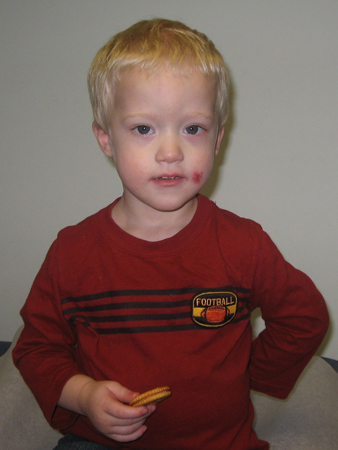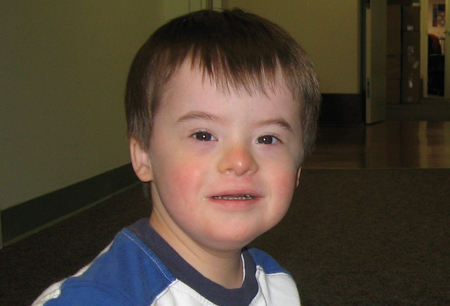History and exam
Key diagnostic factors
common
common physical exam features
Typically include brachycephaly with a flat occiput; epicanthal folds in addition to upslanting palpebral fissures and Brushfield spots of the iris; a short nose with a low nasal bridge and small nares; small ears that may be low-set; a protruding tongue; a downturned mouth with a small oral cavity, extra skin on the back of the neck; short hands with a possible single palmar transverse crease; digital dermatoglyphics; fifth finger clinodactyly; a wide space between first and second toes with vertical plantar creases; and hypoplasia of iliac wings. [Figure caption and citation for the preceding image starts]: Girl with Down syndromeFrom the personal collection of Dr Jeannie Visootsak; photo used with parental consent [Citation ends]. [Figure caption and citation for the preceding image starts]: Boy with mosaic Down syndrome, diagnosed at 18 monthsFrom the personal collection of Dr Jeannie Visootsak; photo used with parental consent [Citation ends].
[Figure caption and citation for the preceding image starts]: Boy with mosaic Down syndrome, diagnosed at 18 monthsFrom the personal collection of Dr Jeannie Visootsak; photo used with parental consent [Citation ends]. [Figure caption and citation for the preceding image starts]: A 5-year-old boy with Down syndromeFrom the personal collection of Dr Jeannie Visootsak; photo used with parental consent [Citation ends].
[Figure caption and citation for the preceding image starts]: A 5-year-old boy with Down syndromeFrom the personal collection of Dr Jeannie Visootsak; photo used with parental consent [Citation ends].
hypotonia
Hypotonia, hyperflexibility of joints, and a poor Moro reflex in the neonatal period.
congenital heart disease
About 50% of all individuals with Down syndrome (DS) have a congenital heart disease (CHD).[17][29][30] Atrioventricular septal defect is the most common form of CHD in DS (31% to 61% in population-based studies of CHD subtypes in DS), with a much higher prevalence than in the general population.[30][32]
gross motor delay
Children with Down syndrome typically present with hypotonia, joint hyperlaxity, and gross motor skills delay. Motor milestones include rolling between 5.0 and 6.4 months, sitting independently by 14.4 months, crawling between 12.2 and 17.3 months, and walking independently by 54 months.[23][24][25]
These milestones may also be impacted by medical conditions such as congenital heart disease or hearing loss.
language delay
Expressive language delay is common and can be complicated by facial features, hearing loss, and recurrent otitis media. Other language deficits include development of variability in the number of different words, intelligibility, and mean length of utterance. Overall, expressive language is more delayed than receptive language.[25][26]
cognitive disability
Cognitive abilities vary greatly, with challenges in the expressive language domain and strengths in visual-spatial tasks. IQ often ranges from mild to moderate intellectual disability, between 40 and 72, and may decline with increasing age. The decline in IQ may be explained by a slowing of the developmental course over the childhood years.[27]
hearing loss
Chronic ear infections and possible hearing loss are common problems for children with DS. For these reasons, aggressive intervention by both the pediatrician and the otolaryngologist starting soon after birth, with meticulous ear cleaning, examination, and aggressive treatment, both medically and surgically, is suggested.[33]
autism spectrum disorder
Large population-based studies of Down syndrome have reported a prevalence of autistic spectrum disorder of about 7% to 19%.[17]
Other diagnostic factors
common
congenital gastrointestinal disorder
constipation
Hypotonia and gross motor delay may contribute to higher rate of constipation.
History of chronic constipation not responding to diet change or stool softeners may indicate Hirschsprung disease.[17]
feeding difficulty
Early feeding problems (e.g., difficulty with sucking or coordination of feeding) may result from hypotonia, small oral cavity, and narrow nares. Lack of oral-motor coordination may delay the introduction of solid foods. Signs suggesting feeding problems include marked hypotonia, being underweight, slow or choking feeds, recurrent or persistent respiratory symptoms, and oxygen desaturation with feeding.[17]
behavioral difficulties
Individuals with Down syndrome (DS) are often social and affectionate. About 20% to 40% of individuals with DS have maladaptive behavioral problems. Age-related patterns of behavioral problems: externalizing behavioral problems (opposition, hyperactivity, impulsivity, inattention) are more common during childhood, and internalizing symptoms (shyness, withdrawal, anxiety) are more common in older adolescents and adults.[27]
Risk factors
strong
advanced maternal age
The most significant factor causing chromosome 21 nondisjunction. Older maternal age at conception influences completion of meiosis and chromosome segregation in the ova.[15]
The incidence of Down syndrome (DS) rises with increasing maternal age as follows: less than 1 in 1000 (age <30 years), 1 in 900 (age 30 years), 1 in 400 (age 35 years), 1 in 300 (age 36 years), 1 in 230 (age 37 years), 1 in 180 (age 38 years), 1 in 135 (age 39 years), 1 in 105 (age 40 years), 1 in 60 (age 42 years), 1 in 35 (age 44 years), 1 in 20 (age 46 years), 1 in 16 (age 48 years), and 1 in 12 (age 49 years).[16]
The total number of pregnancies is far greater among women ages <35 years than among women >35 years. Hence, most newborns with DS are born to women ages <35 years despite having a lower chance of DS.
previous child with Down syndrome
The chance of recurrence for parents of a child with standard trisomy 21 is around 1%, or 1 in 100, until the maternal age-related chance is higher than 1%.[12] For mothers <30 years old, the chance of recurrence is approximately 1.4%. In cases of older maternal age, the rate of recurrence risk is most related to the mother's current age. For example, by age 42 years, the chance is 1 in 60 that a pregnant woman may have a baby with Down syndrome.[16] The reason for this increased chance in women <30 years of age remains unclear but may be related to an age-independent increased chance of nondisjunction or a decreased likelihood of miscarriage of trisomic fetuses.[5] The rate of recurrence for parents with a child with translocation varies depending on the type of inherited translocation. Obtaining parental chromosome karyotype data is necessary before estimating chances of recurrence. Parents of a child with de novo (sporadic events) translocations have the same rate of recurrence as that of standard trisomy 21.[5][12]
Use of this content is subject to our disclaimer